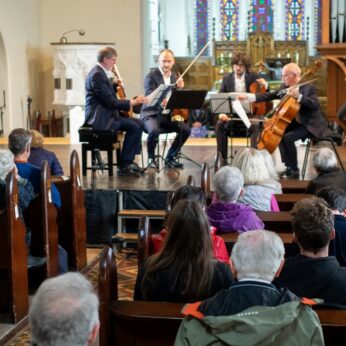Composer: Mieczyslaw Weinberg (b. 1919 - d. 1996)
Performance date: 27/06/2022
Venue: St. Brendan’s Church
Composition Year: 1940
Duration: 00:19:32
Recording Engineer: Simon Cullen, Ergodos
Instrumentation: 2vn, va, vc
Instrumentation Category:String Quartet
Artists:
Quatuor Danel (Marc Danel, Gilles Millet [violins], Vlad Bogdanas [viola], Yovan Markovitch [cello] -
[quartet]

Mieczysław Weinberg [1919-1996]
Quartet No.1 in C major Op.2/141 [1937/1985]
1. Allegro commodo
2. Andante tranquillo
3. Allegro molto
This year Danel Quartet, one of Europe’s top Quartets, celebrates their 30th Anniversary. Almost single-handed the Quartet have succeeded in making the world aware of Weinberg’s powerful set of string quartets composed over almost fifty years, first matching and then exceeding Shostakovich. His First Quartet, written in 1937, was the work of a self-taught teenager in Warsaw playing in his father’s Jewish Theatre. It is deeply ironic that the Festival is featuring the life of a composer, whose entire life hinged on his escape from invading armies, at the same time as his host country launches its invasion of its neighbour.
This Quartet is the work of an untutored but brilliant eighteen-year-old. He was a piano performance student at the Warsaw Conservatoire and had no tuition in composition. A formative experience had been hearing Rachmaninov as soloist in his Second Piano Concerto in 1936. Weinberg’s final piano performance in Warsaw in 1939 before the German invasion was Rachmaninov’s Third Concerto. He dedicated this Quartet to his piano teacher. Its style recalls Bartók’s first two Quartets and those of Szymanowski, whose time as Director of the Warsaw Conservatoire overlapped with his. It is touching that Weinberg returned to this untutored effort nearly fifty years later leaving us with a hybrid of mature technique and youthful inspiration.
The first movement has the aura of a suffocating nightmare whose dense contrapuntal weavings the composer is fighting to escape. There are flashes of clarity, even of beauty, but not until the final bars does the music burst out from its chromatic embrace. In the second movement the instruments are muted giving a dreamy, nocturnal song full of strange unexpected sounds. The Finale is altogether more lively, quickly gathering itself for some Shostakovich-like outbursts – at this point neither composer had heard of each other – so here the young, untaught pianist-composer lays down a marker for both their futures. The gentle whispered coda is a typical Weinberg touch.
Francis Humphrys
Copyright © 2025 West Cork Music. All rights reserved.
Designed and developed by Matrix Internet